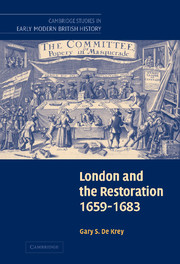Book contents
- Frontmatter
- Contents
- List of figures
- Map
- List of tables
- Preface
- List of abbreviations
- Part I Crisis, 1659–1660
- Part II Settlement and unsettlement, 1660–1679
- Part III Crisis, 1679–1682
- Part IV Crisis and conspiracy, 1682–1683
- Introduction: Whig conspiracy and historical memory
- 7 The London Whigs between law and resistance: conscience, consent, and conspiracy, 1682–1683
- Conclusion: London and the end of the Restoration
- Appendices
- Appendix I 1670 London dissenting subscription
- Appendix II London dissenting common councilmen, 1669–1671
- Appendix III Whig party leaders
- Appendix IV Tory party leaders
- Bibliography
- Index
- Titles in the series
Introduction: Whig conspiracy and historical memory
Published online by Cambridge University Press: 07 May 2010
- Frontmatter
- Contents
- List of figures
- Map
- List of tables
- Preface
- List of abbreviations
- Part I Crisis, 1659–1660
- Part II Settlement and unsettlement, 1660–1679
- Part III Crisis, 1679–1682
- Part IV Crisis and conspiracy, 1682–1683
- Introduction: Whig conspiracy and historical memory
- 7 The London Whigs between law and resistance: conscience, consent, and conspiracy, 1682–1683
- Conclusion: London and the end of the Restoration
- Appendices
- Appendix I 1670 London dissenting subscription
- Appendix II London dissenting common councilmen, 1669–1671
- Appendix III Whig party leaders
- Appendix IV Tory party leaders
- Bibliography
- Index
- Titles in the series
Summary
In June 1683, about a year after the commencement of the London shrieval election of 1682, subjects throughout the kingdom were startled by the government's disclosure of a “horrid conspiracy” of the “fanaticks” to assassinate the king and his brother and to mount an insurrection. After years of loyalist charges about Whig disloyalty, the news concerning this Whig plot was an immediate and lasting sensation that dominated the prints and public conversation for months. Tory writers like Sir Roger L'Estrange and Thomas Sprat were quick to argue that the Rye House Plot, as historians would dub the affair, was a natural conclusion to Whig opposition in parliament and the city. The fanatics had at last been detected in their efforts to return the nation to the circumstances of 1649 or 1659. The fact that most of those apprehended, tried, or executed for their part in plotting were London dissenters or national figures, like Lord Russell and Algernon Sidney, who had kept company with leading civic Whigs, did not escape loyalist notice.
The government's propaganda campaign and its successful plot prosecutions of Russell, Sidney, and many lesser figures enabled it, at last, to gain the upper hand against its opponents. Few were prepared to continue to oppose Charles II, his Catholic successor, or the church leadership, when opposition talk or behavior invited questions about loyalty or provoked suspicions about plotting. The treason trials that began in 1683 permitted a resolution of the Restoration Crisis on uncompromising loyalist terms.
- Type
- Chapter
- Information
- London and the Restoration, 1659–1683 , pp. 335 - 340Publisher: Cambridge University PressPrint publication year: 2005



